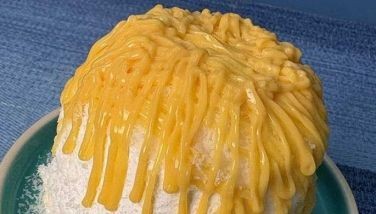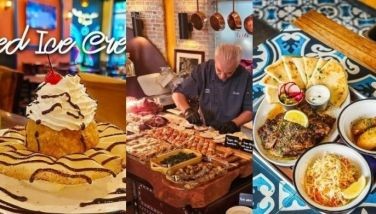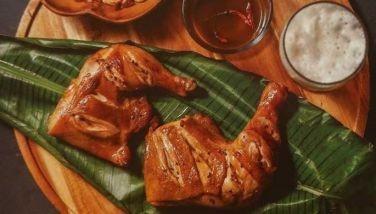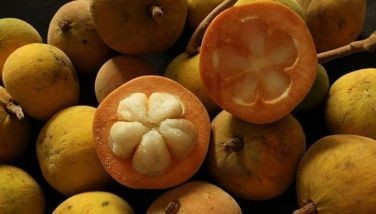How to win a culinary contest
I can never stop working hard. Each day I feel that I have to improve. Hard work ... determination ... I got to keep pushing myself. —Michael Jordan
When Johnlu Koa, owner and CEO of 50 French Baker stores and 50 Chatime tea houses, asked me to judge in the crème de la crème of all baking contests, Le Toques Blanche — loosely translated as the tall white hats worn by accomplished chefs — I was only 20, ecstatic about the opportunity to be part of an event rich in tradition, but at the same time apprehensive. He dispelled all my fears by saying, “Why, Ernest, I saw you literally grow up beside your mom.†Truth be told, mom forgot to enroll me in pre-school and brought me to Brent International School Manila when I was already five years old.
The contest was among the top hotels in Manila, a venue to highlight the best bread most likely to win the Filipino consumers’ hearts. It was quite comical back then because I was so young that even the organizers mistook me for a contestant rather than a judge; thus, I had to be ushered out of the contestant lounge by chef Johnlu to the judges’ booth. Early jitters instantly became a comfortable feeling once the contest started, as fellow judges Raymond Lee and Jessie Sincioco, who are personal friends I grew up with when I would accompany mom to her judging events, put me at ease and said, “Let’s have fun!†I soon realized that a contest was like developing a recipe at home — the process in which we watch, smell, taste and let our senses guide us to decide the best outcome. A total of 10 breads were presented to us, each with their own unique taste and texture. The winner that day was the vegetable mix bread by Nikko Garden Hotel — now Dusit Thani — because the texture was soft and flavor sweet, following the theme that it was the best bread for the Filipino palate and to this day, it is still one of my most memorable bread experiences.
When I got back from my studies at the Ritz Escoffier, Ritz Hotel Paris, Ecole Lenotre (reputed to be the best pastry school in the world), Moulin de Mougins by Alain Llorca (frequently mentioned by New York culinary icon Boulud in his Asian Food Channel’s After Hours with Daniel), and at the Italian Institute for Advanced Culinary and Pastry Arts by John Nocita, whose faculty includes Culinary Olympic gold medalist and 13-time European Bread Champion Nicola Stratoti. The experience provided inspiration, that food has unlimited potential in terms of creativity and it guided me in my blueprint for creating a world-class culinary school, Galastars Culinary, where each student has his own individual station — every station can do all 14 different cooking methods. It also exposed me to two important rules when it comes to winning a competition. First is to understand the ingredients to be used, and second, knowing the style and palate of the judges. In one local tuna competition that I judge, many contestants made the fatal mistake of using over 20 ingredients, thus masking the taste of the main ingredient. Advice to contestants: companies spend millions to promote their product. The winning recipe must be easy to follow and the main ingredient the star attraction.

In a conversation I had with chef John Nocita (who promised to teach at Galastars Culinary), he stated that the reason why Italian cuisine wins many European culinary events is because “they have mastered the art of using the 14 best ingredients, break it down to the correct proportions and allow every ingredient to complement each other rather than overwhelm and confuse the taste buds.†This also makes preparation easy, thus giving you time to plate beautifully and correct mistakes. He advises, “You may have an award-winning dish but if you can’t finish on time it just won’t happen!†He jokingly added that this is why Italian chefs are more relaxed in the kitchen compared to their French counterparts. Knowing the judges is equally important. Nationality, culinary background and style, whether traditionalist or Nouveau, all play a major role. Like wine, it’s about pairing the right dish with the right judge. If the theme is local, why use foreign ingredients? If a judge likes simple cuisine, why present a molecular gastronomy dish? In many instances contestants confuse themselves with fusion, or the art of combining two different styles to make one unique dish. Master both techniques first and make it simple to get the best results.
When director GB Sampedro of TV 5 made me a mainstay with two other judges in the noontime show Celebrity Cook Off, two chef instructors with two novice celebrities were given one minute to pick from a market basket and tasked to replicate a dish presented at the start of each show. Using the correct or incorrect ingredients, they must cook within 30 minutes, with the winner being that whose dish resembled the original dish. With time pressure and chef instructors only allowed to view through a camera mounted on top of the contestant’s head, this proved to be an exciting and challenging event. Speed, attention to detail and improvising under difficult circumstances are keys to victory.
A few months ago, managing director of Urban Kitchen and Melawares Charmaine Chua asked me to draw up the mechanics of a culinary contest Cusina Idol. Finalists would be chosen by recipes, with the finished products posted on their website. A total of seven were chosen, the venue at Galastars Culinary.
Finalists were allowed to have one hour for preparation, and a second hour for cooking with two main ingredients: Sea King Bangus and Magnolia Chicken for each recipe. Criteria for scoring included 5 percent for cleanliness, 15 percent for originality, 40 percent taste, 40 percent plating and presentation using the Melawares exquisite Japanese plate collection or the hotel line porcelain plates. Contestants varied from housewives to culinary students. Competition was fierce with each participant showcasing amazing skills and creativity. Judges meticulously noted down the scores and we all agreed in the panel that it would be a close match. At the end of the day there was one winner, Justin Tee, who created a unique and witty interpretation of chicken tinola and cucumber tinapa rolls. His keys to success were using his mom’s chicken tinola stock and reconfiguring the chicken by making it into a roulade. The stock was only added just before the judges were to taste to keep the chicken tender and stock warm using the Melawares Japanese teapot. The flavors were so balanced, precise, clean, and the texture was so soft it just melted in your mouth with every bite. His cucumber tinapa was elegantly plated and the fish smoked to perfection, making the bangus shine. He was the most prepared, being the first contestant to arrive three hours before the event, carefully visualizing the cooking sequence to be done and the only participant that brought complete ingredients.
Chance favors the prepared mind. Justin left nothing to chance and was ready to win. His prize was P500,000 worth of kitchen tools from Urban Kitchen and Melawares, a P100,000 gift check from Sea King Seafood, two gas stoves from Unifab Metal Industries, and gift checks from Magnolia Poultry courtesy of marketing manager Jake Lugay.
My advice to culinary students: never give up and continue to improve. Practice makes perfect, and always remember that ultimately, taste is king.
- Latest
- Trending

























